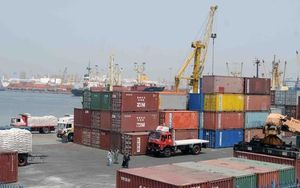Stock futures saw a modest rise on Wednesday night, April 16, 2025, following a steep sell-off in the previous session that rattled investors. Futures tied to the Dow Jones Industrial Average added 62 points, or 0.15%. S&P 500 futures advanced by 0.2%, while Nasdaq 100 futures climbed 0.3%. This slight uptick came as a relief after major stock indexes experienced significant declines earlier in the day, primarily driven by a sharp drop in technology stocks and escalating tariff concerns.
On Wednesday, the Dow Jones Industrial Average plummeted by 1.7%, losing nearly 700 points. The S&P 500 dropped about 2.2%, while the tech-heavy Nasdaq Composite saw a decline of nearly 3.1%. By the end of the session, the Nasdaq was approximately 19% off its closing high, edging closer to bear market territory.
Among the companies hit hardest was chipmaking giant Nvidia, which saw its shares tumble by 6.9% after announcing a quarterly charge of about $5.5 billion. This charge was attributed to U.S. export controls that limited the export of its H20 graphics processing units (GPUs) to China and other markets. Other semiconductor stocks, including AMD and ASML, also faced significant sell-offs as investors reacted to the growing uncertainty surrounding U.S. tariffs.
The market turmoil intensified during Wednesday afternoon after Federal Reserve Chair Jerome Powell addressed the Economic Club of Chicago. He warned that President Trump's tariffs could lead to increased inflation in the near term, stating that the central bank might find itself in a "challenging scenario" where its dual-mandate goals of achieving maximum employment and stable prices are in conflict. "Despite the fact that Powell said that the dual mandate wasn't currently in opposition, he clearly touched a nerve with investors, who are now worried that a recession and stagflation is more likely," noted Chris Zaccarelli, chief investment officer for Northlight Asset Management.
This volatility in trading has been ongoing since Trump announced his sweeping "reciprocal" tariffs on April 2, 2025. Many of these tariffs were put on hold for 90 days last week, even as tensions with China escalated rapidly. Trump's unexpected tariff exemption on smartphone and PC imports, announced over the weekend of April 12-13, provided a brief respite for markets, leading to gains on Monday, April 14, 2025. However, the positive momentum quickly dissipated, resulting in back-to-back losing days for major averages.
As the earnings season ramps up, investor concerns about the economic impact of tariffs are growing. Peter Boockvar, chief investment officer at Bleakley Financial Group, expressed his concerns on CNBC's "Fast Money," stating, "I think the economy is on very weak knees right now." The S&P 500 and Nasdaq have both dropped approximately 6% and 5.7%, respectively, in April, while the 30-stock Dow has lost about 5.6% this month.
In his remarks, Powell indicated that larger-than-expected tariffs could lead to higher inflation and slower growth. His comments ignited further selling in stocks, which were already under pressure from Nvidia's sharp decline and similar drops in other chipmakers. "Powell is confirming what investors have been worried about, and that is the likelihood of slowing economic growth and more stubborn inflation as a result of the tariffs," said Sam Stovall, chief investment strategist at CFRA Research.
As part of the ongoing U.S.-China trade conflict, China recently raised its tariffs on imports of U.S. goods to 125% in retaliation for Trump's actions, which effectively raised U.S. tariffs on Chinese goods to 145%. The escalating trade tensions have left investors seeking certainty in a landscape that appears increasingly volatile. Gina Bolvin, president of Bolvin Wealth Management Group in Boston, remarked, "The markets and investors want certainty and of this much I am certain: this year will be a more difficult year for investors than the last two cake walks."
The Dow Jones Industrial Average fell 699.57 points, or 1.73%, to close at 39,669.39 on April 16, 2025. The S&P 500 lost 120.93 points, or 2.24%, finishing at 5,275.70, while the Nasdaq Composite fell by 516.01 points, or 3.07%, to close at 16,307.16. During the session, the Nasdaq had dropped as low as 16,066.46.
Wall Street's fear gauge, the Cboe Volatility Index, rose, ending the day at 32.64. Nvidia's stock drop of 6.9% was mirrored by a 4.1% decline in an index of semiconductor stocks. Additionally, AMD shares fell by 7.3%, reflecting the broader concerns about the impact of tariffs on the tech sector.
ASML, a Dutch chip-making tools giant, also warned that the tariffs had led to increased uncertainty about its outlook. Bill Northey, senior investment director at U.S. Bank Wealth Management, highlighted the fluidity of tariff implementation details, stating, "Markets continue to digest tariff implementation details that remain fluid, and as a result investors', businesses' and consumer uncertainty just remains incredibly high." He added that companies are beginning to cite impacts from tariffs and the generally negative implications that uncertainty is breeding.
On the Nasdaq, 1,469 stocks rose, while 2,964 fell, leading to a declining issues to advancers ratio of 2.02-to-1. The total volume on U.S. exchanges was 16.08 billion shares, compared to the more than 18 billion average for the full session over the last 20 trading days. This indicates a market still grappling with the implications of ongoing trade tensions and economic uncertainty.




